Pioneering the Understanding & Treatment of Hearing Loss
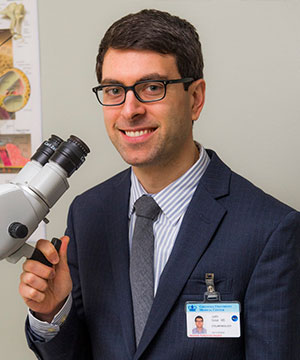
Justin S. Golub, MD, MS, otologist/neurotologist, NewYork-Presbyterian/Columbia
Our centers for hearing loss and other disorders of the ear are led by the nation’s leading otology and neurotology specialists. Our multidisciplinary teams care for patients of all ages with ear, hearing, balance, and related skull base disorders, including:
- Tinnitus
- Dizziness
- Infectious and inflammatory diseases of the ear
- Facial nerve disorders
- Cholesteatomas
- Congenital malformations of the ear
- Tumors of the ear, acoustic nerve, and skull base
Both campuses offer comprehensive audiology services, including central auditory processing evaluations, vestibular assessments, and electrophysiological testing. Patients benefit from customized hearing aid fitting, including bone-anchored hearing aids, as well as medical and surgical treatments, and a comprehensive team approach to cochlear implantation that includes experienced pediatric and adult cochlear implant audiologists, speech therapy, school educator, and healthcare navigation for as long as they need it. Our clinical services are bolstered by robust basic science and clinical research aimed at clarifying the roots of hearing loss and improving treatments.
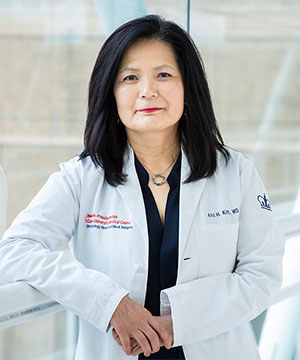
Ana H. Kim, MD, Director, Cochlear Implant Program, NewYork-Presbyterian/Columbia
Understanding age-related hearing loss. Columbia University researchers are leaders in the understanding of age-related hearing loss (ARHL) and its relationship to other variables. They have demonstrated links between ARHL and depression, cognitive impairment, and dementia. Moreover, preliminary brain imaging studies show smaller brain volumes as well as white matter tract dysfunction in adults with hearing loss. These findings suggest that prevention or treatment of hearing loss may be an effective strategy for managing depression and cognitive impairment. Our investigators have also created innovative big data analytical models to show that older age is not a significant predictor of cochlear implant performance when controlling for confounders. With funding from the National Institutes of Health, otolaryngology investigators at Columbia University are now collaborating with Department of Psychiatry researchers to study the effects of hearing loss on cognition, depression, and social withdrawal in the elderly.
Predicting hearing aid success. Weill Cornell Medicine investigators are exploring ways to predict how well individuals with hearing loss will fare once they begin using hearing aids. Patients do not always do as well as doctors would like, so researchers would like to identify markers of hearing aid success and failure.
Pursuing gene therapy. NewYork-Presbyterian/Columbia is one of four centers in the world conducting a clinical trial in which cellular regeneration is being used to treat hearing loss. Most causes of hearing loss are due to the death of inner ear hair cells. The study is assessing an investigational drug called CGF166 containing a gene that has been shown in laboratory studies to produce hair cells.
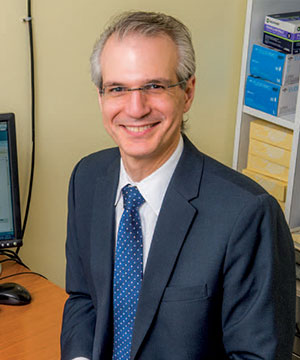
George Alexiades, MD, Director, Cochlear Implant Center, NewYork-Presbyterian/Weill Cornell
Clarifying auditory mechanics. Laboratory scientists at Columbia University’s Fowler Memorial Lab are exploring the workings of the “cochlear amplifier,” the hair cells responsible for boosting sound signals entering the inner ear. Only a quarter of hair cells in the inner ear — the inner hair cells closest to the auditory neurons — send messages to the brain to translate sound into hearing. The remaining outer hair cells take on the task of amplifying incoming signals and also greatly enhance the differentiation of a sound into its various frequencies. Hearing aids amplify sound volume but lack the localized action of the natural ear’s amplifier and cannot fully replace it. Fowler Lab investigators are among just a handful of researchers in the world using in vivo laboratory models to measure hair cell motion, electrical responses, and driving pressures in the inner ear to glean vital insights that elevate the understanding of normal hearing. They are also seeking to understand the basis of high-fidelity transmission of the middle ear.
Improving cochlear implants. To improve outcomes in cochlear implantation, scientists from the Fowler Lab developed a nontraumatic hydro-assisted method using viscous fluid to “carry” the implant into the cochlea, thereby preventing damage. With funding from the National Institutes of Health — and working with collaborators from Columbia University Engineering, Harvard University, and MIT — they designed an intracochlear microphone to serve as a component of a cochlear implant, which would overcome one of the biggest burdens of conventional cochlear implants: having to wear a portion of the device externally, including a magnetic disc on the scalp. They continue to refine the microphone to improve sensitivity and reduce unwanted feedback.
The cochlear implant program at Columbia University continues to expand as researchers identify more patients who may benefit from this treatment. Newer implants have electrodes that are thinner and more flexible, allowing for the preservation of the cochlea and residual hearing. There are also implants called “electric acoustic stimulation” that combine cochlear implants to stimulate the middle and high frequencies in individuals with age-related hearing loss whose low-frequency hearing is sufficient or amenable to hearing aid use. In addition, Columbia University has one of the area’s largest programs assessing cochlear implants for people with single-sided deafness.
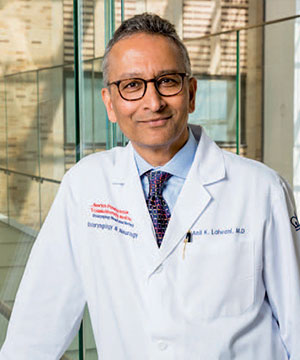
Anil K. Lalwani, MD, Co-Director, Cochlear Implantation Program, NewYork-Presbyterian/Columbia
Drug delivery to the cochlea. Current methods to administer drugs to the cochlea to treat hearing loss, vertigo, and tinnitus are limited by an inconsistent rate of molecular transport across the round window membrane (RWM). Researchers from Columbia University’s Departments of Otolaryngology and Engineering have teamed up to devise a novel way to introduce one or more microscopic perforations through the RWM using a 3D-printed microneedle to enhance the rate and reliability of drug diffusion; it is being assessed in a laboratory model.
Enhancing music enjoyment in cochlear implant users. Many users of cochlear implants struggle with music perception, particularly with pitch-based and melodic musical elements. Columbia University investigators have found that re-engineering music to reduce its complexity by reducing harmonics and reverberation time improved music enjoyment for cochlear implant users.
Seeking effective treatment for chronic tinnitus. Ringing in the ears is one of the top two ear problems reported by military personnel (the other being noise-induced hearing loss) and has been linked with depression in people who experience it chronically. With funding from the U.S. Department of Defense, Columbia University otolaryngology and psychiatry investigators are collaborating on a pilot study assessing the use of intravenous ketamine to treat tinnitus. If the results are positive, this therapy could become the first effective treatment for chronic tinnitus.
Understanding brain damage from noise trauma. Recent studies have suggested that noise, such as that associated with high-volume music on headphones or earbuds, not only destroys hair cells necessary for hearing, but also causes neuro-inflammatory changes and irreversible damage to neurons in parts of the auditory centers of the brain. Columbia University scientists have created a mouse model to explore the pathophysiology of such traumatic noise-induced hearing loss to better understand this process and identify potential therapeutic targets. Treatment for sudden noise-induced hearing loss must be initiated within seven to 10 days of the trauma to avert permanent neuronal damage. The investigators would also like to explore the role of genetic sensitivity to noise-induced hearing loss.
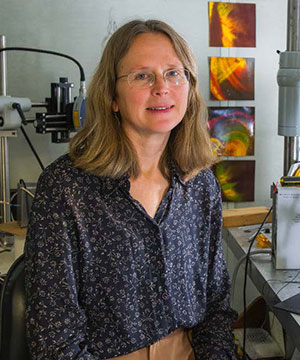
Elizabeth S. Olson, PhD, Professor of Biomedical Engineering and Auditory Biophysics, NewYork-Presbyterian/Columbia
Improving hearing after acoustic neuroma treatment. Many patients with acoustic neuroma experience hearing loss in the affected ear. While contralateral rerouting of sound hearing aids — bringing sound from the deaf to the hearing ear — bone-anchored hearing aids, and cochlear implants are effective options for hearing rehabilitation, some patients forego these treatments, choosing instead to make modifications for the rest of their lives to listen only through the “good ear.” Weill Cornell Medicine investigators are conducting research to understand why acoustic neuroma patients make the choices they do after treatment — such as the choice of a particular hearing rehabilitation technique versus the decision to go without — with the goal of optimizing hearing after surgery.
Cost-effectiveness studies. Our researchers have conducted studies to delineate the most cost-effective approaches to evaluating patients with sensorineural hearing loss and vertigo.
Selected Publications
- Age-related hearing loss and its association with depression in later life. American Journal of Geriatric Psychiatry. 2018;26(7):788-96.
- Sensation and psychiatry: Linking age-related hearing loss to late-life depression and cognitive decline. American Journal of Psychiatry. 2018;175(3):215-24.
- Brain changes associated with age-related hearing loss. Current Opinion in Otolaryngology and Head and Neck Surgery. 2017;25(5):347-52.
- Observed hearing loss and incident dementia in a multiethnic cohort. Journal of the American Geriatrics Society. 2017;65(8):1691-97.
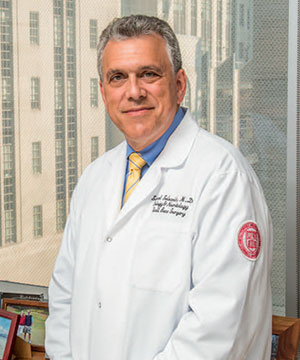
Samuel H. Selesnick, MD, Vice Chairman, Department of Otolaryngology, Weill Cornell Medicine
- Assessing cochlear implant performance in older adults using a single, universal outcome measure created with imputation in HERMES. Otology & Neurotology. 2018;39(8):987-94.
- A novel perfusion-based method for cochlear implant electrode insertion. Hearing Research. 2014;314:33-41.
- An intracochlear pressure sensor as a microphone for a fully implantable cochlear implant. Otology & Neurotology. 2016;37(10):1596-1600.
- Cost-effective analysis of unilateral vestibular weakness investigation. Otology & Neurotology. 2015;36(2):277-81.
- Cost analysis of asymmetric sensorineural hearing loss investigations. The Laryngoscope. 2010;120(9):1832-36.
- In vitro perforation of the round window membrane via direct 3-D printed microneedles. Biomedical Microdevices. 2018;20(2):47.
- Reduction of the harmonic series influences musical enjoyment with cochlear implants. Otology & Neurotology. 2017;38(1):31-37.
- Reverberation time influences musical enjoyment with cochlear implants. Otology & Neurotology. 2015;36(2):e46-50.
- Specific targeting of retrocochlear auditory pathway for optimal pharmacotherapy delivery using a mouse model. Otology & Neurotology. 2012;33(6):1085-91.
- Connexin 43 (Cx43) and hearing: Possible implications for retrocochlear auditory processing. The Laryngoscope. 2013;123(12):3185-93.
- Electric-acoustic stimulation. Otolaryngologic Clinics of North America. 2019;52(2):311-22.
- Impact of underlying diagnosis on speech and quality of life outcomes after cochlear implantation in single-sided deafness. Accepted Otology & Neurotology.



